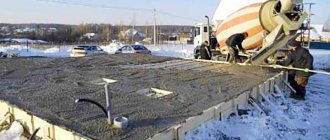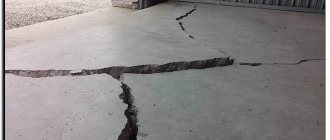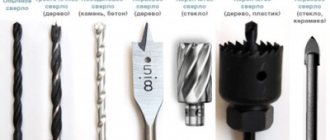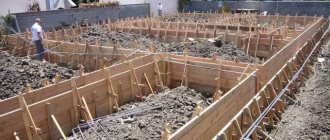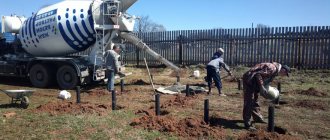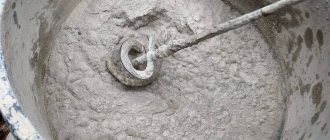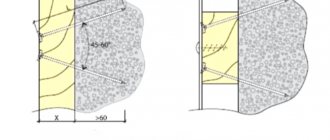- February 23, 2020
- Construction
- Daisy Angel
Concrete is one of the most popular materials in construction. The most suitable conditions for its hardening are considered to be an ambient temperature of + 20 ˚С. But sometimes you have to pour concrete at sub-zero temperatures. In this case, it is better to use the services of specialists.
Water can become an obstacle to quality work. It is needed in concrete not only for fluidity. Water performs an important function in the hardening process. At low ambient temperatures, it changes from a liquid state to a solid state (turns into ice). This stops the hardening process and promotes the destruction of bonds formed before freezing.
Concrete can harden even at a temperature of -4 °C. However, if it drops below + 5 ˚С, then the hardening process slows down, and the strength gain is suspended and resumed only when it becomes warmer outside. The longer the stagnation in the hardening process, the less strength the material will gain. This means that at low temperatures it is necessary to provide conditions under which the concrete will not freeze and will continue to gain strength.
Use of additives
If you are interested in knowing how to pour concrete at sub-zero temperatures, then you should familiarize yourself with the technology of using additives. Antifreeze substances are not very expensive and are widely available. If you purchase ready-made concrete, then all additives should already be in it. In this case, the temperature values in a specific area are taken into account.
Additives contain chemical impurities - salts of monocarboxylic acids, sodium formate and nitrite. They speed up the hardening process, prevent water from freezing, and also increase the final strength of the material. The main disadvantage of using various additives is that such substances cope with their work only at -5 ˚С. If you are interested in at what negative temperature concrete can be poured, then you should know that in severe frosts, although some additives will work, hardening will not begin as quickly as required by technology. Ultimately, the lack of strength can be 30%. Some additives are aggressive towards metal reinforcement. They destroy it, causing the structure to lose strength.
Increasing the grade of concrete for water resistance and frost resistance
Concrete mixture is a popular construction material for many reasons. First of all, due to reliability and strength, durability and ease of use, the ability to create a wide variety of projects based on the composition, as well as other qualities, including high levels of water resistance and frost resistance.
By improving these qualities, we increase the general characteristics of the material, making it absolutely problem-free in subsequent maintenance and increasing its service life.
It has long been known that special finishing or even waterproofing of concrete does not always cope with the task, and it quickly deteriorates due to exposure to the same atmospheric phenomena. We definitely don’t need this at our dacha, because if we are building a house, garage or even a small gazebo, we need the structure to last for a very long time.
Therefore, it is advisable to use special additives that have a positive effect on the quality and characteristics of concrete, especially when it comes to foundations and plinths, where protection is most needed. They can also include floors in the shower, on the area near the garage, where we often wash the car, in swimming pools, as well as in structures that are built on sites with a high groundwater level.
To obtain the desired characteristics, bituminous substances, surfactants, as well as components with the maximum inclusion of sodium aluminate are introduced into the composition. They work simply - they fill the pores in the finished concrete.
We have already said that often not one, but several additives are used at once, or several characteristics are improved with a certain composition. So, to improve water resistance qualities, you can use silicate glue, the same liquid glass, which increases the grade of concrete in terms of frost resistance and water resistance, and also increases the setting speed of the mixture and future strength.
Benefits of Using Supplements
Many people want to know how to pour concrete at sub-zero temperatures. In order not to make a mistake, you first need to familiarize yourself with all the advantages and disadvantages of a particular method. The most common technology is the addition of additives. They have one significant advantage - this approach allows concreting to be carried out at any time of the year.
Using additives, it is possible to transport concrete mortar at low temperatures. To ensure high-quality setting of the material, it is not necessary to use additional heating systems. When antifreeze additives are added, a concrete monolith receives additional strength, and the solution consumption is reduced (if compared with a material prepared according to a conventional recipe).
What is added to the solution in winter?
The most common ingredient is antifreeze additives. The industry produces them in liquid and dry states, for different temperatures. There are also options for concrete,
for masonry work, plaster, for bricks, for blocks...
Interestingly, with the help of such components, the cement mortar has time to harden before it freezes. When additives and cement are combined, heat is released and the solution heats itself.
As you know, the hydration process is long, the main thing is to prevent the monolith from freezing at the stage of primary solidification.
Many people ask the question: why do they add salt to cement mortar?
Salt has been added to the solution for a long time, but gradually the introduction of new materials and chemical additives replaced table salt. Moreover, after it white efflorescence often appears on the brick. We have to wait a couple of years for them to be washed away by rain and snow.
The main disadvantages of antifreeze additives
In order to pour concrete at sub-zero temperatures without compromising the quality of the material, it is necessary to become familiar with the disadvantages of anti-frost additives. Firstly, they can lead to the appearance of salt crystals on the surface, which are almost impossible to remove. Secondly, sometimes they reduce the strength of concrete stone. This happens if the proportions are calculated incorrectly, and the cooking or setting technology is broken. Thirdly, individual components may be unsuitable for use in residential areas as they are toxic.
Advantages and disadvantages
The use of additives extends the service life of the finished structure and helps speed up the hardening process of the solution.
Antifreeze additives have a number of advantages:
- increase the strength of the monolith;
- extend the service life of the finished structure;
- increase the frost resistance and moisture resistance of the mixture;
- reduce the risk of shrinkage and deformation of the erected structure;
- accelerate the hardening of the solution;
- prevent corrosion and premature destruction of the surface.
However, pouring concrete in winter using special additives also has a number of disadvantages, such as:
- increasing cement consumption to increase the strength of concrete;
- release of toxins from the additive components;
- if the rules for making a frost-resistant concrete mixture are violated, the surface will lose its declared qualities.
Heating technology
Many novice craftsmen do not know at what temperature concrete should be heated. It is important to take into account one rule: if the thermometer drops below + 5 ˚С, then the hardening process slows down. To avoid this, heating must begin when the ambient temperature drops below this mark. You can do this as follows:
- pass current through the concrete using an electrode;
- pass current through a wire pre-laid inside the material.
The first method is cheaper, since metal rods can act as electrodes. If you follow the rules, you will need special equipment for these purposes. However, some craftsmen connect a welding machine to the reinforcing electrodes, passing current through the solution and heating it. Reinforced concrete is heated at a voltage of up to 127 V. Without metal reinforcement, voltages of up to 380 V should be used.
The second method involves additional costs for the heating cable. It is laid with a reinforcement frame. Current is connected to it through substations. This method is more expensive, but is more effective compared to heating using electrodes.
The main disadvantage of the above method can be called financial costs. In addition, when heating, you need to constantly monitor the temperature. If it rises excessively, this will cause the material to dry out and may compromise the strength of the structure. If frosts are severe, the formwork should be additionally insulated. Now you know at what temperature you need to heat concrete.
Plasticizers for concrete
A very thick composition does not fit well into the formwork; it does not have the necessary plasticity and does not go into hard-to-reach places. Very often, the task of pouring is complicated by reinforcement, especially very thick reinforcement, where the material does not fall at all, leaving voids that negatively affect the strength.
You could add water to the concrete mixture to make it more liquid. But this cannot be done, because then the grade of the composition in terms of water resistance and frost resistance is reduced, and the solution itself loses in quality. Moreover, this cannot be done in winter, when frost can seriously damage the concrete.
Therefore, today, as, in principle, many years ago, plasticizers are used to increase the plasticity of concrete.
At private construction sites in the Soviet Union, ordinary soap, washing powders, as well as lime and clay were often used. But today there are special additives on the market that increase the plasticity of concrete. They work on the principle of facilitating the sliding of concrete mixture particles, that is, they reduce the internal friction of the mass.
Plasticizers are often used in summer cottage construction and in winter; it is only necessary that the preparation recipe meets the requirements as much as possible.
Warming during hardening
It is allowed to use conventional insulation methods. This is true if the ambient temperature is not lower than 5 degrees Celsius. Most often, the formwork (if any) is insulated, as well as visible parts of the concrete. For this purpose, you can use all kinds of materials, such as sawdust or polystyrene foam.
One of the most popular ways is to create a tent around the object. Heating guns can be installed inside such a structure. This method has the disadvantage that the concrete must be at a predetermined temperature when supplied. In addition, conventional insulation without additional heating will be ineffective if there is severe frost outside.
Dosage and consumption
The amount of antifreeze additive required depends on the following factors:
- strength of the cement used;
- ambient temperature indicator;
- chemical composition of the protective mixture.
How much additive is required to obtain a certain strength of concrete mortar is presented in the table:
| Average air temperature | Amount of additive,% of total mass | Expected strength of the solution, % of the grade when hardening in the cold, day | |
| 7 | 28 | ||
| 0 to -5 | 2 | 25 | 60 |
| -6 to -10 | 3 | 15 | 45 |
| -11 to -15 | 4 | 5 | 35 |
Types of antifreeze additives
To pour concrete at sub-zero temperatures, which additive should I choose? The following types of these products are available on the market:
- Antifreeze.
- Sulfates.
- Antifreeze additives.
Antifreezes are substances that reduce the crystallization temperature of a liquid and speed up the setting time of the material. Sulfates are additives that accelerate hardening as much as possible and generate heat, so that the components of the solution mix faster and become a homogeneous mass. This lowers the freezing point. On sale you can find antifreeze additives called accelerators. These components are able to increase the rate of dissolution of silicate components, which react with the products of solution hydration. This ensures the formation of basic and double salts, which reduce the freezing point of the mixture.
Features of concreting in winter
Concrete work in winter conditions at sub-zero temperatures is contraindicated. This is due to the fact that the water included in the cement-concrete mortar already at a temperature of 0 ° C begins to freeze and crystallize. This process leads to the mixture losing its physical and technical properties. As a result, a hard cement stone is formed, which after thawing becomes loose and flaky. Antifreeze additives in cement prevent the freezing process of the solution, so concrete work can continue without warming up even in winter.
Concreting, when the temperature drops below zero, can be carried out in 3 main ways:
- Thermos method for winter concreting. Used for arranging massive structures. A solution is poured into the insulated formwork, which gradually gains the required strength due to the heat generated.
- Methods of aging in artificial shelters. The construction of greenhouses is carried out, where the optimal temperature required for hardening of the concrete solution is maintained.
- Chemical additives for concrete. They reduce the freezing point of water, which has a positive effect on the quality of hardening of the solution.
Winter concreting methods can be combined with each other. The choice of one method or another depends on the area of the surface to be poured, the type of composition and the required strength of the concrete surface.
Antifreeze additive CemFrio
Among the inexpensive offers on the market, CemFrio should be highlighted. It is designed to increase the strength of material poured at sub-zero temperatures. This complex additive is used not only for concrete, but also for other mortar mixtures. It accelerates hardening and provides a plasticizing effect. Concreting with its use can be carried out at temperatures up to - 20 ˚С.
Prefabricated monolithic or monolithic concrete, as well as reinforced concrete structures can be erected with its help. The additive prevents the possibility of their destruction when exposed to negative temperatures. This substance should be dosed with a larger margin, focusing on the approximate readings of the thermometer during the day (not only during the day, but also at night) throughout the entire stage of hardening of the solution. In this case, the strength gain of concrete at sub-zero temperatures will be ensured in the range from + 10 to - 20 ˚С. At the same time, the need to add water to mortar mixtures is reduced by 5%, and the strength characteristics increase by 10%.
What happens to concrete at sub-zero temperatures?
Often, the construction of a foundation is accompanied by a sudden change in temperature: the monolithic mass began to solidify, and at night frost hit and everything froze. Once thawed, it will harden while repairing damaged areas. According to experienced builders, a one-time freeze-thaw cycle is allowed at a relatively low minus outside. If the rules are followed, installation in winter can be done in the same way as in summer. An important feature is the delivery of the finished heated mixture with a mixer, the construction of insulated formwork, the use of additional materials to cover the base, and mandatory waterproofing of the surface.
To give concrete high strength characteristics, the sand must be quarry-sown or washed. This type has a rough surface, which gives high adhesion to cement.
The crushed stone in the solution should also be quarry grade - thanks to its rough surface, it quickly sets with cement laitance and sand.
How to heat concrete yourself
Now you know that you can pour concrete in cold weather in different ways. If you do not want to use the appropriate additives, use the solution heating method. For this purpose, they most often work with electrodes. This is due to the simplicity and low cost of the method, because there is no need to use heating wires and transformers. This method is based on the physical properties of electric current, which passes through a conductor and releases a certain amount of heat.
The conductive material is concrete. When current passes through a water-containing solution, it heats it. If the concrete structure contains a reinforcement frame, it is not recommended to apply a voltage of more than 127 V to the electrodes. If such a structure does not exist, you can use both 220 V and 380 V. It is not recommended to apply a higher voltage.
If we pour concrete in cold weather, we can use different materials for heating, for example, rod electrodes. To create them, you should take metal reinforcement with a diameter of 8 to 12 mm. Such rods are inserted into concrete at a certain distance from each other and connected to different phases.
If the design is complex, heating electrodes will be indispensable. Fiberglass reinforcement is not suitable for such purposes, since it is a dielectric. Electrodes in the form of plates can be used. In this case, the heating circuit is very simple. The plates must be placed on opposite sides of the poured solution and connected to different phases. The passing current will heat the concrete.
Sometimes craftsmen use narrow stripes. The principle of their operation is the same as that of the plates. Electrodes can also be string electrodes. They are used when pouring columns, pillars and beams. The principle of operation is similar. The strings should be connected to different phases. Warming up with electrodes must be carried out with alternating current, since direct current passing through water promotes electrolysis. In this case, the water will chemically decompose without fulfilling its role in the hardening process. Now you know whether concrete is poured at sub-zero temperatures.
So what to do?
If it is undesirable to postpone construction, and it is not very cold outside, then you can use Portland cement with an increased hardening speed (its marking has the letter R). To use it, first two-thirds of the water is heated to about 70 degrees. Then sand and gravel are added to it. Finally, the remaining third of water and cement are added to the mixture.
This solution needs to be kneaded twice as long as usual. The time of vibration compaction also increases by one and a half times. Before pouring the solution, check if there is any ice or snow on the formwork. Warm up the underlying layer. After pouring the concrete, you need to cover its surface with a polymer film - it will protect the surface from rapid freezing.
If all this does not inspire confidence in you, then it is better to wait until the air temperature rises to +5 degrees and above. But winter filling is fraught with the following financial losses:
- the construction budget increases by a third;
- even a thaw is not a reason not to add anti-frost additives during winter work;
- in winter you will need to order ready-made concrete (it simply cannot be prepared on site), therefore, you will also have to order delivery;
- and in order to heat what is being poured, you will also need to resolve the issue with electricity.
Lyudmila Gubaeva
Real Estate Tatarstan
Infrared and induction methods
If you are thinking about how to pour concrete in sub-zero temperatures, you can also use the induction method. It is mainly used in crossbars, beams and purlins. This method is not very common due to the complexity of the device. It consists in the fact that the insulated wire creates induction and heats the fittings around which the element is wound.
Warming up using infrared rays is based on the ability of the latter to heat the surface of transparent objects with heat transfer throughout the volume. When using this method, the concrete should be wrapped in a transparent film, which will transmit the rays through itself, preventing the heat from quickly evaporating. The advantage of such heating is that transformers do not need to be used. The method also has a drawback. It is expressed in the inability of infrared radiation to uniformly heat large structures.
If you plan to pour concrete in sub-zero temperatures, you should know that the method described above is only suitable for thin structures. Regardless of what type of electric heating is used, you need to monitor the temperature. If it rises above +50˚C, it will create dangerous conditions. The heating rate (as well as cooling) should not exceed 10 ˚C per hour.
Kinds
Existing additives have different effects on the physical and chemical properties of concrete. In total, three mechanisms of their antifreeze action can be distinguished:
- lowering the crystallization temperature of water , promoting the normal course of setting reactions (antifreeze);
- accelerating the hardening process and reducing the time until concrete reaches critical strength (setting accelerators);
- dissolution of initially insoluble components of concrete in water . The final result is similar to the effect of antifreeze, but the detrimental effect on the integrity and aesthetics of the concrete monolith is much less.
The most common are the first two types of additives - antifreeze and set accelerators. Inorganic and organic salts (chlorides, nitrates, sulfates, carbonates and formates of alkali and alkaline earth metals), as well as organic compounds (urea), are used as antifreeze additives.
How winter concreting with the use of anti-frost additives occurs/works, whether such concrete needs to be heated - we will talk about all this further.
What other substances can be used to heat concrete mortar?
We looked at how many degrees below zero it is possible to pour concrete. It should be said that antifreeze additives are most often used. Among others, it is allowed to use calcium carbonate, which is also called potash. This crystalline antifreeze component accelerates the hardening of concrete and is recommended for use exclusively together with sodium tetraborate (sulfide-yeast mash). Many people know it better under the name “borax”.
Calcium carbonate added in its pure form may reduce the strength of the structure. The amount of sodium tetraborate and mash should be no more than 30%. When choosing additives for concrete at sub-zero temperatures, you must take into account that potash is a dangerous substance. It can only be used in compliance with safety precautions. Sodium tetraborate can be used as a stand-alone additive. This additive is a mixture of sodium, ammonium and calcium salts. The sodium tetraborate impurity preserves the structure of the structure. Borax eliminates the occurrence of cracks and reduces the water permeability of concrete. Its strength increases by 30%.
Is it possible to add salt to concrete in winter and use modifiers?
The temperature threshold for water crystallization is reduced by adding special additives. This allows for standard cement hydration to occur during cold winter conditions.
The preparation of mixtures with antifreeze additives is carried out in a special manner
Specialized stores offer various plasticizing substances, along with which the following available components are used in private housing construction:
- calcium salt of hydrochloric acid;
- potassium carbonate, known as potash;
- technical salt (sodium chloride);
- sodium nitrate.
Regular salt is popular among private developers, allowing it to partially reduce the crystallization threshold. However, its maintenance does not guarantee the preservation of the performance characteristics of concrete. The use of industrially produced additives is preferable.

